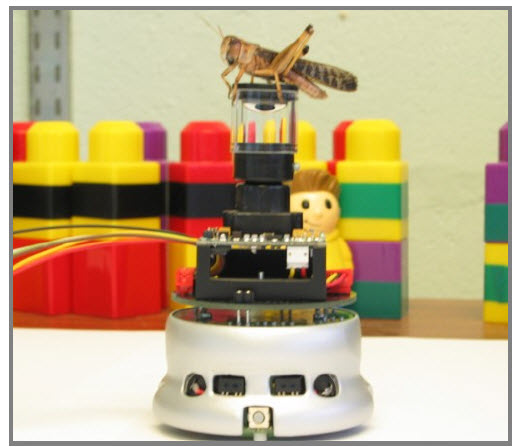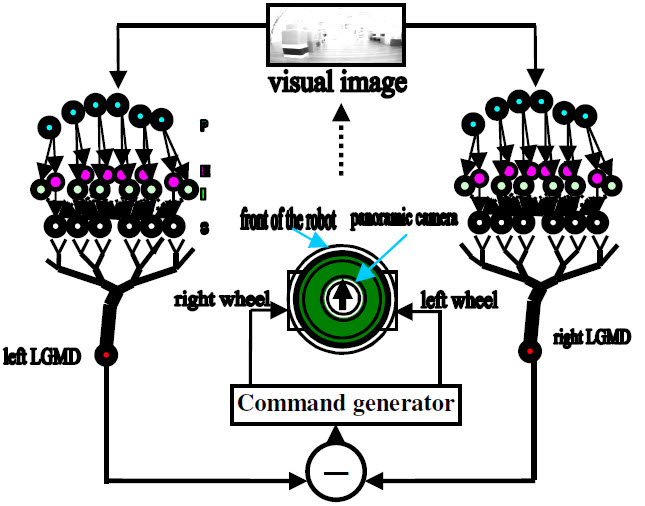Insects inspiring new robot vision technology for collision avoidance
February 25, 2013

Khepera II robot (credit: Shigang Yue and F. Claire Rind/International Journal of Advanced Mechatronic Systems)
A computerized system that allows for autonomous navigation of mobile robots based on the locust’s unique visual system has been created by scientists from the University of Lincoln and Newcastle University
The work could provide the blueprint for the development of highly accurate vehicle collision sensors, surveillance technology, and even aid video game programming, according to the researchers.
Locusts have a distinctive way of processing information through electrical and chemical signals, giving them an extremely fast and accurate warning system for impending collisions.
Professor Shigang Yue from the University of Lincoln’s School of Computer Science and Dr. Claire Rind from Newcastle University’s Institute of Neuroscience were inspired by the powerful visual processing power built into these insects’ biology.

Schematic illustration for the Visually Stimulated Motor Control system for a mobile robot with panoramic vision. The images captured by the panoramic vision camera of the Khepera II robot are
transformed and split into two halves fed to the left and right visual neural networks, based on the locust’s lobula giant movement detector (LGMD). The visual cues are compared and then results are sent to a controller that outputs motor commands to control the left and right wheels in real time. (Credit: Shigang Yue and F. Claire Rind/International Journal of Advanced Mechatronic Systems)
The research started by understanding the anatomy, responses and development of the circuits in the locust brain that allow it to detect approaching objects and avoid them when in flight or on the ground.
A visually stimulated motor control (VSMC) system was then created, which consists of two movement detector types and a simple motor command generator. Each detector processes images and extracts relevant visual clues which are then converted into motor commands.
A collision-avoidance system for autonomous vehicles
“We created a system inspired by the locusts’ motion sensitive interneuron — the lobula giant movement detector (LGMD),” said Yue. “This system was then used in a robot to enable it to explore paths or interact with objects, effectively using visual input only.”
Funded by the European Union’s Seventh Framework Program (FP7), the research was carried out as part of a collaborative project with the University of Hamburg in Germany and Tsinghua University and Xi’an Jiaotong University, China.
The primary objective of the project is to build international capacity and cooperation in the field of biologically inspired visual neural systems.
“Effective computer vision is a major research challenge,” said Yue. “Vision plays a critical role in the interaction of most animal species, and even relatively low order animals have remarkable visual processing capabilities. For example, insects can respond to approaching predators with remarkable speed.
“This research demonstrates that modelling biologically plausible artificial visual neural systems can provide new solutions for computer vision in dynamic environments. For example, it could be used to enable vehicles to understand what is happening on the road ahead and take swifter action.”
“Developing robot neural network programs, based on the locust brain, has allowed us to create a program allowing a mobile robot to detect approaching objects and avoid them,” said Rind. “It’s not the conventional approach, as it avoids using radar or infrared detectors, which require very heavy-duty computer processing. Instead it is modeled on the locust’s eyes and neurons as the basis of a collision avoidance system.
“Taking this work forward we want to apply it to collision avoidance systems in vehicles which is a major challenge for the automotive industry. While some collision-avoidance features are pricey options on luxury cars, their performance is not always as good as it could be — and they come at a high cost. This research offers us important insights into how we can develop a system for the car which could improve performance to such a level that we could take out the element of human error.”